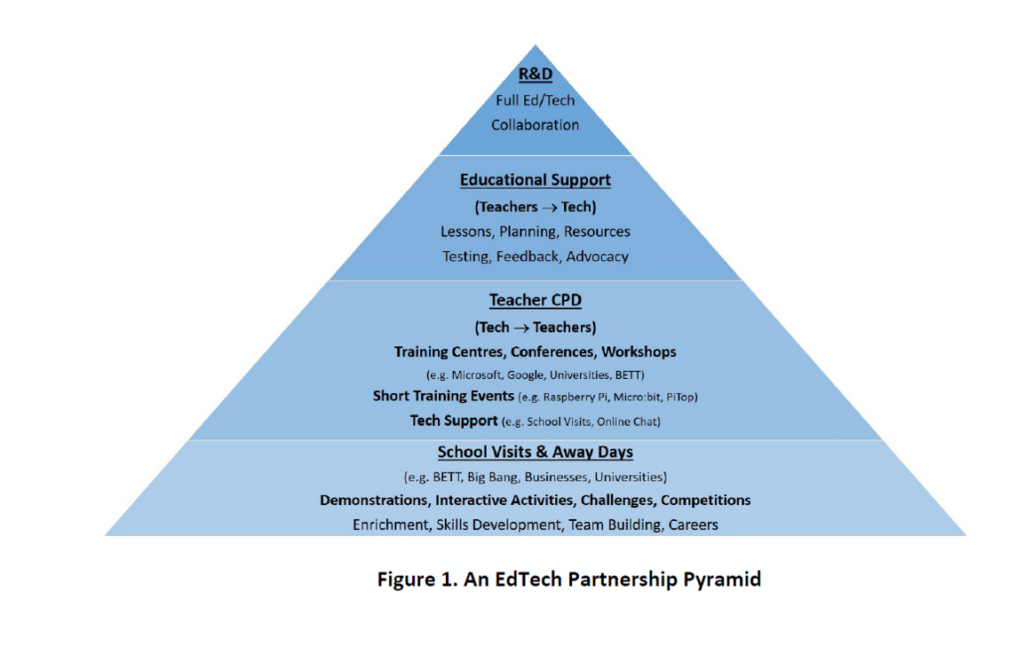Makerspaces in Education

Makerspaces are learning environments that facilitate hands‐on learning by providing students with access to tools and technologies.
Makerspaces in Education and Promoting EdTech Partnerships
Makerspaces are learning environments that facilitate hands‐on learning by providing students with access to tools and technologies in order to:
- Bridge the ‘Digital Gap’ by providing training in Industry 4.0 skills.
- Promote creativity, resilience and innovation.
- Prepare students for the careers of the future.
Makerspaces can provide both an invaluable space and an invaluable opportunity to knit together the often, disparate strands of Ed Tech in schools through partnerships with Industry Leaders.
These partnerships are providing opportunities for students to understand the significance of new technologies and acquire the skills needed to use them should not be underestimated. Makerspaces provide an ideal means by which to achieve this.
EdTech Partnerships: building the pyramids
Whilst many schools, as part of their enrichment programmes, take small groups of students to large national events and/or local businesses to see technology in action, explore possible careers or participate in regional challenges or competitions, such events and activities form only a small part of the potential range of partnerships schools and technology companies can form together.
Figure 1 shows a Pyramid of such Partnerships with traditional enrichment visits at its base and some additional examples of the kinds of partnerships that schools could explore. Whilst enrichment visits are no doubt of huge benefit to those who attend, they suffer from two main issues. First, they are usually ‘one‐off’ events and second, they are typically not whole‐school and so many students, often our most disadvantaged ones, can be left behind.

An EdTech Partnership Pyramid
The second layer of the pyramid shows a different kind of partnership between teachers and technology companies in which the latter provide CPD (training) to the former to enable them to ‘roll‐out’ technology across their schools over time. This not only enables teachers to develop whole programmes of learning (as opposed to one‐day events), but reaches more students and facilitates deeper learning through iteration and practice.
A third kind of EdTech partnership works the other way. In this, teachers work with companies who have existing EdTech products on the market to develop with/for them, lessons and teaching resources to make best use of these products. Teachers help EdTech companies find the ‘best fit’ within the curriculum, help these companies understand the constraints under which schools operate and provide a test‐pit for their products with real students in real schools that allows for more meaningful feedback and hence future improvement of learning.
Finally, the tip of the pyramid shows the ideal partnership; one in which educators and technology companies work together to research and develop a technology product and the educational resources to go with it before it goes to market to ensure the ‘best fit’. Such collaboration, although uncommon, is extremely enriching to both partners and both emerge from the process with a much greater understanding of the world in which each works. Not only this, but it avoids the square peg, round hole’ problem ‐ something quite common in EdTech. This is where a tech company develops a product without consultation with educators, that does A,B & C, only to find that when they take it into schools, that what was really wanted was something that did D, E &F. Had only they asked…
Whether we love it or loath it, EdTech is not only here to stay but is set to become one of the biggest technology sectors going forward. Add to this, the ever increasing use of robotics, AI, machine learning in manufacturing, big data analytics and UX to tailor our online experiences; media streaming, e‐commerce, video conferencing, remote learning, RFID and NFC tags in supply chains, digital fabrication and CRSPR in medicine, and FinTech products and blockchain in global markets and we can begin to understand why a solid grasp of all things digital is crucial to the future of our students… and in all this, partnership is the key. Having a makerspace program can offer the prospects to have a physical location within a school to develop, enrich and innovate the curriculum and develop opportunities to enhance learning for students.

